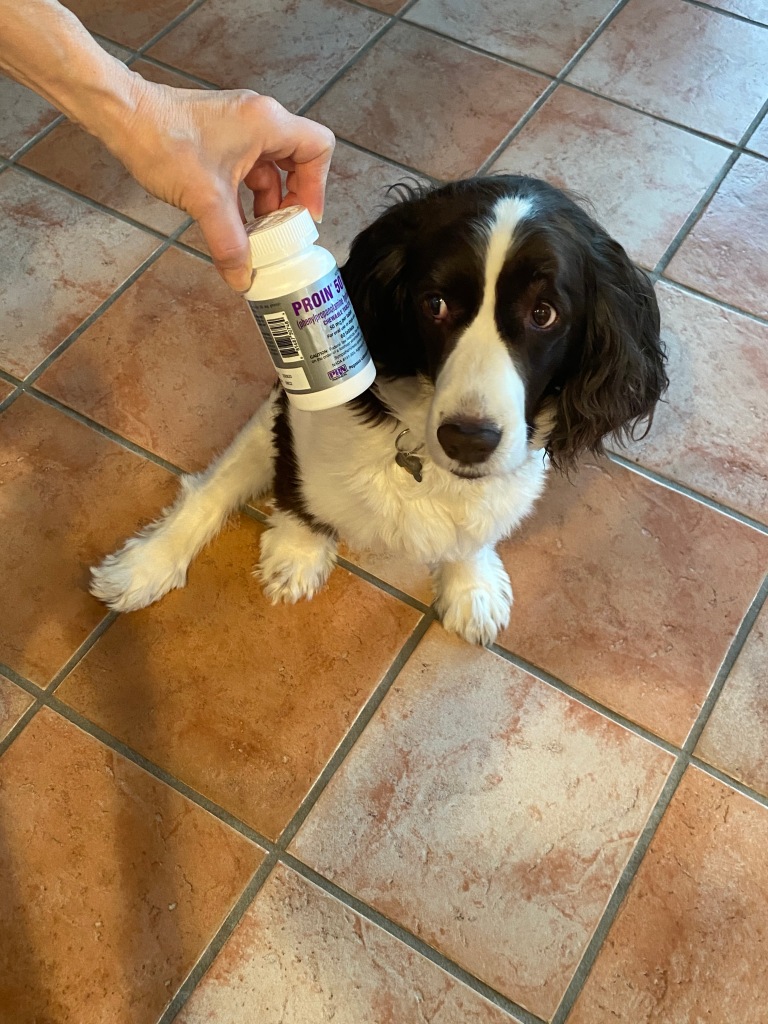Andrew Siegel MD 8/14/2021
How fitting that a urologist’s dog has developed urinary control issues! Our 10-year old female English Springer Spaniel—Charley Morgan—has begun to leak urine on the kitchen floor, at times a puddle and at other times a spray or mist, sometimes a wake of wet. At other times, there is no obvious puddle or trail, but her backside becomes soaked.
Clearly, no one is happy about the situation, particularly my wife—who is obsessive about cleanliness and keeps a Swiffer Wet Jet at hand. Charley Morgan (the Spaniel) also does not seem to be particularly happy about wetting herself and the kitchen floor, appearing dismayed, embarrassed and at times mortified by her situation. She is an intelligent and expressive pet who makes incredible eye contact and I truly believe that her issue has rattled her and resulted in a loss of doggy self-esteem and even sadness.
To manage the problem, we tried restricting her fluid intake somewhat and taking her out to pee more frequently in an effort to keep her bladder as empty as possible (classic behavioral techniques). I brought home urinary dipsticks from the office to test her urine to ensure that she didn’t have a urinary infection, glucose in the urine (that would indicate diabetes) or protein in the urine (that would indicate kidney disease), all of which may cause urinary incontinence. When she squats to pee, she tends to get dirt in her crotch (male canines and male humans clearly have an advantage over female dogs and women, respectively, not having to squat to pee) and has had a number of urinary infections in the past, so we try to maintain hygiene as best as possible and even tried a short course of antibiotics to minimal avail.
Older female dogs tend to get “senior incontinence” from weakened sphincter muscles. Trying to teach a human how to do Kegel pelvic floor exercises is challenging enough, but trying to teach your dog is an entirely different story! However, the muscles that a dog uses to wag their tails are the pelvic floor muscles, so keeping your canine happy, as reflected by lots of tail wagging, will likely help the cause. Interestingly, weak pelvic floor muscles are rarely observed in such animals—despite giving birth to large litters—suggesting that with constant movement of the tail the pelvic floor muscles are exercised sufficiently to maintain tone or to restore function following injury. Maybe my next book will be “Kegels for Beagles“!
As a urologist, I often treat patients with urinary incontinence. At one time it was possible to use an over-the-counter sympathomimetic medication (one that stimulates the sympathetic nervous system, mimicking the sympathetic nervous system’s flight or fright response) that functions to tighten up the muscle tone of the urethra, increasing urethral resistance and improving urinary control. This was commonly used in conjunction with pelvic floor muscle exercises as first-line management of stress incontinence. The medication used was phenylpropanolamine (PPA). Since it is a stimulant, it was also used as an appetite suppressant medication. Because of concerns about elevating blood pressure and possibly precipitating strokes, as well as potential abuse in the manufacture of amphetamines, it was removed from the USA market in 2006 under federal legislation to regulate retail over-the-counter sales of ephedrine, pseudoephedrine, and PPA– the Combat Methamphetamine Epidemic Act. Although PPA is no longer available for humans, it is still available for veterinary use in dogs and cats under the brand name Proin. This medication was brought to my attention by my sister-in-law, Betsy, who swore by this medication for her dog with canine senior incontinence.
To my great dismay, a medical doctor cannot write a prescription for an animal (something that I have never quite understood!). After Charley Morgan’s incontinence issue declared itself as being consistent, I contacted Charley’s veterinarian who graciously mailed over a prescription for chewable Proin. These pills must appeal to canine taste buds because Charley readily consumes them without the need for disguising them by wrapping them in a piece of cheese or other food. Charley has been using the Proin for a few months now, and to date there have been fewer puddles, trails and droplets on our kitchen floor. With fewer incontinence episodes, we have a happier dog and a much happier wife (happy wife, happy life!). Charley is by no means cured, but clearly improved.
A few words on Sudafed (Pseudoephedrine), a PPA-like medication
Sudafed is similar to phenylpropanolamine (PPA) and is still available for human use. It is commonly used as a nasal decongestant since it constricts blood vessels that are responsible for stuffed noses. As a sympathomimetic medication, it can also cause excitability, nervousness, anxiety, and insomnia. Because it constricts blood vessels, it can also cause hypertension and cardiac arrhythmias. In urology, the drug is often used for men with prolonged erections that may occur after penile injection therapy for erectile dysfunction. Because Sudafed constricts smooth muscle in the urethra, it can cause urinary difficulties, including urinary retention, (hence the warnings with medications that contain Sudafed ) and for this reason can actually help improve urinary incontinence. Perhaps we should rethink using pseudoephedrine (similar to PPA) for human stress urinary incontinence. Sudafed is available in pharmacies behind the counter. The FDA sets limits on how much Sudafed can be purchased in a given time period, because of its use as an ingredient in the manufacture of methamphetamines. Although rules vary by state, generally consumers must show a photo ID and sign a log when purchasing the drug.
Bottom Line: Senior dogs–particularly senior female dogs–like senior humans, often develop bladder control issues. Aside from behavioral modification (fluid restriction and timed voiding) and Kegel pelvic floor exercises, there are medications that can help the problem, some–like Proin– geared to under-active urethral muscles and others to over-active bladders. Whether you are a human or canine, help is available!
Wishing you the best of health,


A new blog is posted weekly. To receive a free subscription with delivery to your email inbox visit the following link and click on “email subscription”: www.HealthDoc13.WordPress.com
Dr. Andrew Siegel is a physician and urological surgeon who is board-certified in urology as well as in female pelvic medicine and reconstructive surgery. He is an Assistant Clinical Professor of Surgery at the Rutgers-New Jersey Medical School and is a Castle Connolly Top Doctor New York Metro Area, Inside Jersey Top Doctor and Inside Jersey Top Doctor for Women’s Health. His mission is to “bridge the gap” between the public and the medical community. He is a urologist at New Jersey Urology, the largest urology practice in the United States. He is the co-founder of PelvicRx and Private Gym. His latest book is Prostate Cancer 20/20: A Practical Guide to Understanding Management Options for Patients and Their Families.

Video trailer for Prostate Cancer 20/20
Preview of Prostate Cancer 20/20
Andrew Siegel MD Amazon author page
PROSTATE CANCER 20/20 is now available at Audible, iTunes and Amazon as an audiobook read by the author (just over 6 hours).
Dr. Siegel’s other books:
PROMISCUOUS EATING— Understanding and Ending Our Self-Destructive Relationship with Food
MALE PELVIC FITNESS: Optimizing Sexual and Urinary Health
THE KEGEL FIX: Recharging Female Pelvic, Sexual, and Urinary Health
Tags: Andrew Siegel MD, canine urinary incontinence, phenylpropanolamine, Proin, urinary incontinence


August 15, 2021 at 7:21 PM |
Great information! Thank you 😊
On Saturday, August 14, 2021, Our Greatest Wealth Is Health wrote:
> Our Greatest Wealth Is Health posted: ” Andrew Siegel MD 8/14/2021 Charley > Morgan How fitting that a urologist’s dog has developed urinary control > issues! Our 10-year old female English Springer Spaniel—Charley Morgan—has > begun to leak urine on the kitchen floor, at times a puddle and ” >